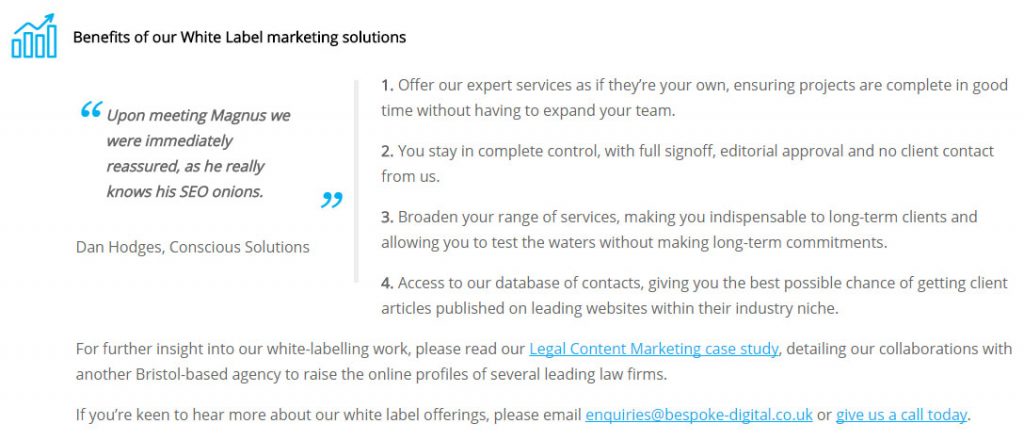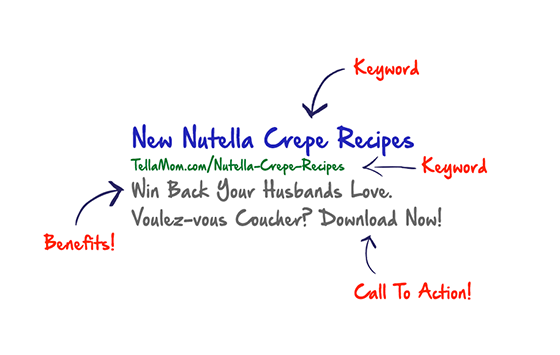At its heart, copywriting is all about boosting your bottom line. There’s much debate surrounding the blurred line between content and copy, but copywriters ultimately have roots in the advertising industry, crafting messages to drive direct sales.
Content marketing, on the other hand, can be considered more of a long-term approach, framing your company as a voice of authority via educational, informative material that earns attention, retains audiences and enhances search engine visibility. There’s no doubting effective copywriting skills are essential for successful content, but it’s much more of a soft sell.
As such, traditional sales copywriting should be reserved for your service pages, special offers and promotions – wherever you want audiences to take action. It’s often said that people no longer like being sold to in a traditional manner, which is why content marketing is crucial to online success, but you still need money in the bank to keep the lights on, hence captivating copy being essential to your continued success.
Here’s how and where to produce sexy sales copy that converts:
Copywriting skills that pay the bills
The key thing to bear in mind when writing web copy is that your readers will invariably be in a hurry, scanning pages to pick out the most pertinent information. If they can’t easily find what they’re looking for, it’s highly likely they’ll hit the ‘back’ button and land on your competitor’s site via Google.
Thus, brevity is your best friend for individual product pages.
This may seem contradictory to our advice on forming a content marketing strategy, where we propose writing around 500 words for service pages and 1,000+ words for blog posts – the theory being that more words gives you room to say something meaningful, which also helps search engines understand, and therefore rank, your content – but you can afford to be more succinct with product pages.
Here’s what SEO expert Joost de Valk, CEO of Yoast, has to say on the matter:
So rather than worrying about optimising every single page for search, you’ll probably find you have much better luck focusing efforts on your category/service pages, and keeping the text for individual products brief.
To aid the user experience, you should:
- Use bullet points to highlight the key features of each product and break up huge blocks of text, creating white space that makes the page more readable.
- Anchor technical information with emotions, e.g: ‘These boxer shorts are made from 100% Egyptian cotton. No more painful chafing when you’re out on your morning jog!’
- Make the Call To Action (CTA) clear and easy, using phrases such as ‘Add to basket’, ‘Subscribe here’ and ‘Download now’.
Ultimately, your sales copy should focus on the product benefits rather than the product itself. You want your audience to consider how it’s going to help them solve a problem or improve their life in some way.
If you’re a service provider rather than a retailer, think about your target customer and how you can alleviate their pain points. For example, this is a screenshot of our White Label SEO service page:

We understand that many marketing agencies struggle with the finer points of SEO and influencer outreach campaigns, which is why we offer our white labelling work to complete their projects in a timely manner.
Note how we talk directly to our target customer (partner agencies) using variations of ‘you’ and ‘your’ throughout, showing we understand what it’s like to be in their shoes, reassuring ‘you stay in complete control’ and explaining how we ‘broaden your range of services, making you indispensable to long-term clients…’
This message resonates, as there’s a strong emphasis on how our services can benefit others.
We’ve also made it easy for interested parties to follow up, linking to both our email address and contact page. Collectively, these elements combine to ensure our prospective clients know exactly how we can help, leading to a steady stream of white label work.
Tricks for clicks
Some people believe pay-per-click (PPC) advertising, such as on Google AdWords and Microsoft Bing Ads, negates the need for content marketing and SEO, because you can buy your way to the top of search results regardless of how much attention you pay to your actual web content.
Needless to say, this is a shortsighted way of thinking for reasons too numerous to mention here, but, at the end of the day, for any PPC campaign to be successful, you need quality copywriting on both your advert and your landing page. The former to drive traffic, the latter to boost conversions.
Within AdWords, you’re limited to:
- Headline 1: 30 Characters
- Headline 2: 30 Characters
- Description: 80 characters
That’s only 140 characters to pique interest, so your copywriting game has to be on fire.
Conducting keyword research is a prerequisite, and the AdWords Keyword Planner will provide you with plenty of handy hints, but make sure your ad text contains variations of your target phrases, meaning they’ll appear in bold when people search for them, drawing eyeballs to your ad over a competitor’s.
Jonathan Dane of Klientboost prescribes the following formula for success:

Once people click your way, your landing page must be slick enough for them to stay. In terms of copy, that means bearing the principles of keywords, benefits and strong CTA’s in mind throughout.
What’s of critical importance for quality PPC, is that you create bespoke landing pages for each ad. For instance, if we were to promote our social media marketing services on AdWords, we’d be sure to set the destination as our social media marketing page.
Directing users to our homepage and forcing them to scout our site to find the service they’re actually looking for would inevitably lead to frustration and high bounce rates. This may sound obvious, but it’s a stumbling block that many newcomers to search marketing succumb to.
Once people hit your targeted landing page, you have to charm the pants off them and make the buyer journey as straightforward and compelling as possible, which is why copywriting is an essential part of PPC.
Some marketers invest huge portions of their budget into PPC, and see targeted traffic come in droves, only to find conversions remain stagnant. Naturally, many point the finger at whoever’s in charge of running the AdWords account, but nine times out of ten it’ll be down to poor quality landing pages, so it pays to invest in quality copy before going headlong into PPC.
Ultimately, successful marketing relies on analysis and refinement, optimising campaigns at regular intervals. The godfather of copywriting, David Ogilvy, agrees:
Your Friday Ogilvyism #DavidOgilvy pic.twitter.com/lXsN4akN7E
— Ogilvy & Mather (@Ogilvy) April 28, 2017
Testing should be central to all online marketing activities, and tweaking your sales copy is no exception. The beauty of web copy is you can update it whenever you like, testing the waters to see what works until you strike gold.
If you’d like more advice on spicing up your sales copy, email enquiries@bespoke-digital.co.uk. We’re also offering a FREE Digital Health Check to kickstart your SEO, so drop us a line or give us a call on 0117 230 6010.
If you have any comments or questions about this post, or would like to discuss a specific issue with your site, please get in touch using the form below.
And connect with us on social media to stay upto date with our latest news:

